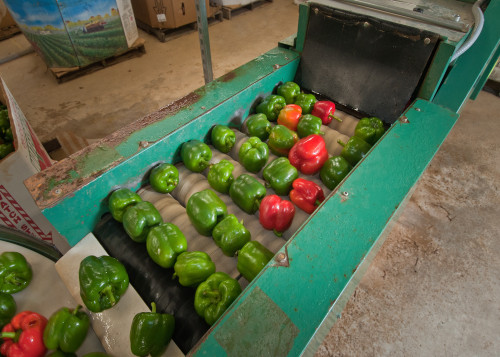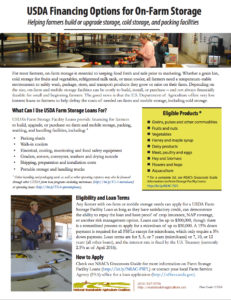
Small and mid-scale family farms operating in burgeoning local and regional food markets received some welcome news from the U.S. Department of Agriculture (USDA) today.
USDA’s Farm Service Agency (FSA) announced that their Farm Storage Facility Loan (FSFL) program can now help finance portable storage structures, agricultural duty motors supply, portable equipment, and storage and handling trucks in addition to continuing its longstanding capacity to finance stationary crop and cold storage on-farm facilities. This expansion of the low-interest loan program will help FSA better serve fruit and vegetable farmers and others who need to get crops safely and efficiently to local farmers’ markets, schools, restaurants, food hubs, and retail stores.
The loan storage program’s expansion to cover mobile equipment and vehicles came via a federal rulemaking that was published on the Federal Register on Friday, April 29 and becomes effective immediately upon publication.
About Mobile Farm Storage Loans

The new program changes announced this week will allow financing for portable storage structures, portable equipment, and storage and handling trucks under FSA’s Farm Storage Facility Loan Program. Previously, only permanently-affixed and stationary equipment and facilities were eligible for financing under this low interest federal loan program.
Portable storage and handling equipment includes components such as:
- augers
- batch dryers
- bulk tanks
- conveyors (Check out California Industrial Rubber Co. (for conveyor belt lacing)
- pilers
- scales
- storage containers
- steel wheels Australia
- vacuums, and
- other necessary farming equipment such as a 4in1 bucket used to handle and transport agricultural commodities.
This program expansion will allow FSA to better serve all of the financing needs associated with farmers’ storage and handling needs. For example, if a farmer grows primarily fruits and vegetables to sell at local farmers’ markets, that farmer is now able to use a Farm Storage Facility Loan to purchase equipment to weigh vegetables, forklifts to handle the fruits and vegetables, portable storage containers to store fruits and vegetables for short or extended periods of time, as well as a refrigerated truck to transport that stored produce to market.
Eligible portable storage facilities include manufactured storage containers that may be used when transported, hitched, or mounted on a trailer or truck for the purpose of storing and handling eligible commodities. Those who operate a trucking business that transports agricultural products to different markets may need to secure Overweight Permits to comply with local or federal regulations.
All mobile storage and handling trucks must be registered with the applicable State Motor Vehicle Administration (MVA) and all State and local MVA laws, insurance, and title provisions must be adhered to before loan disbursement.
Portable handling equipment includes, but is not limited to:
- hydraulic self-propelled fork lifts
- wheel loaders
- grippers
- skid steers
- front-end loader attachments
- 3-point hitch lifts
Additionally, farmers will now be able to secure financing for both new and used portable storage and handling equipment. Portable used storage and handling equipment have not previously been eligible for an FSFL. Used and portable handling equipment is often less expensive than permanently affixed equipment, which is especially beneficial to smaller farm operations that may have lower gross incomes available to repay these or other farm loans.
New Microloans Available for Farm Storage
In addition to the new eligibility for mobile equipment, the program changes also provide for an easier loan application process with less paperwork for small farm storage loans under $50,000. FSA is still able to make loans of up to $500,000 under the program, but the new “microloan” option might be attractive to small and beginning farmers who may be looking for a smaller loan with less red tape involved. Cashify small loans online will require only a 5 percent down payment versus the 15 percent required for larger loans.
In order to qualify for this new microloan, a producer’s total outstanding balance for all of their outstanding FSFLs must be less than or equal to $50,000 at the time of loan application and disbursement. For example, if a farmer has already secured a FSFL in any amount greater than $50,000, they are ineligible to apply for a microloan until their existing loan is paid off. However, if they have only applied for and received a FSFL in the amount of $20,000, they would be eligible to apply for a $30,000 microloan.
If applying for a FSFL microloan, farmers will be able to self-certify their production history and storage needs, rather than being required to document 3 years of production history by filing an acreage reporting form on an FSA-578 to qualify for a microloan.
This loan requirement modification will hopefully open the program up to more smaller start-up farm operations, which may not be able to meet the existing 3-year production requirement.
The loan terms for farm storage microloans are shorter than larger loans – 3, 5, and 7 years, depending on the amount of the loan. The other loan terms remain the same as other larger farm storage loans. Check out our Grassroots Guide for more details on additional loan requirements.
Continued Improvements to Farm Storage Loans
In the past two years, FSA has made several significant changes to the program to in an attempt to reach more farmers – especially those farmers growing fruits and vegetables and those serving local markets.
For example, in 2014, FSA expanded the program to make packing sheds eligible for financing. This is where fruits and vegetables are washed, sorted, graded, labeled, boxed up, and stored before they head to market.
And in 2015, FSA expanded program eligibility to unprocessed meat and poultry, eggs, milk, cheese, butter, yogurt, flowers, hops, rye, and aquaculture – products previously not included in the FSFL program. The agency also started to coordinate the storage loan program with other federal farm credit programs, so farmers can put together loan packages more easily to cover a wider range of financing needs.
Those earlier changes did not require a change in federal regulations, but the change announced today to cover mobile structure, equipment, and vehicles and to create a “microloan” option needed to go through the rulemaking process, and hence took a bit longer to bring online.
Visit NSAC’s Grassroots Guide to learn more about loan purposes, eligible commodities, and how to apply.
NSAC issued a press release this morning, stating our support for these recent program changes and applauding FSA for this additional expansion of the program to cover the needs of additional farmers and to help make the program more relevant to local and regional food markets. NSAC has been working with FSA to make these changes to serve the needs of a more diverse range of farm businesses, and we are very pleased with the results.
Coupled with the changes from the past two years, today’s announced expansion of the program will help farmers keep food safe, facilitate new markets, and better serve the expanding customer base for healthy, local and regional food.


eye opening piece, and thought provoking